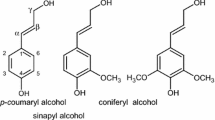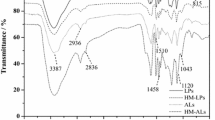Abstract
Wood artefacts undergo complex alteration and degradation during ageing, and gaining information on the chemical composition of wood in archaeological artefacts is fundamental to plan conservation strategies. In this work, an integrated analytical approach based on innovative NMR spectroscopy procedures, gel permeation chromatography and analytical pyrolysis coupled with gas chromatography/mass spectrometry (Py-GC-MS) was applied for the first time on archaeological wood from the Oseberg collection (Norway), in order to evaluate the chemical state of preservation of the wood components, without separating them. We adopted ionic liquids (ILs) as non-derivatising solvents, thus obtaining an efficient dissolution of the wood, allowing us to overcome the difficulty of dissolving wood in its native form in conventional molecular solvents. Highly substituted lignocellulosic esters were therefore obtained under mild conditions by reacting the solubilised wood with either acetyl chloride or benzoyl chloride. A phosphytilation reaction was also performed using 2-chloro-4,4,5,5-tetramethyl-1,3,2-dioxaphospholan. As a result, the functionalised wood developed an enhanced solubility in molecular solvents, thus enabling information about modifications of lignin, depolymerisation of cellulose and structure of lignin-carbohydrate complexes to be obtained by means of spectroscopic (2D-HSQC-NMR and 31P-NMR) and chromatographic (gel permeation chromatography) techniques. Py-GC-MS was used to investigate the degradation undergone by the lignocellulosic components on the basis of their pyrolysis products, without any pre-treatment of the samples. The application of all these combined techniques enabled a comprehensive characterisation of the whole cell wall of archaeological wood and the evaluation of its state of preservation. High depletion of carbohydrates and high extent of lignin oxidation were highlighted in the alum-treated objects, whereas a good preservation state was found for the untreated wood of the Oseberg ship.

ᅟ







Similar content being viewed by others
References
Braovac S, Kutzke H. The presence of sulfuric acid in alum-conserved wood—origin and consequences. J Cult Herit. 2012;13(3):S203–S8.
Almkvist G, Persson I. Degradation of polyethylene glycol and hemicellulose in the Vasa. Holzforschung. 2008;62:64–70.
Tamburini D, Łucejko JJ, Modugno F, Colombini MP. Combined pyrolysis-based techniques to evaluate the state of preservation of archaeological wood in the presence of consolidating agents. J Anal Appl Pyrolysis. 2016;112:429–41.
Braovac S, Tamburini D, Łucejko JJ, McQueen C, Kutzke H, Colombini MP. Chemical analyses of extremely degraded wood using analytical pyrolysis and inductively coupled plasma atomic emission spectroscopy. Microchem J. 2016;124:368–79.
Walsh Z, Janeček ER, Hodgkinson JT, Sedlmair J, Koutsioubas A, Spring DR, et al. Multifunctional supramolecular polymer networks as next-generation consolidants for archaeological wood conservation. Proc Natl Acad Sci U S A. 2014;111(50):17743–8.
Chaumat G, Blanc L, Albino C, editors. Study of the azelaic/palmitic acids association to treat waterlogged archaeological wood. Proceedings of the 11th ICOM-CC Group on Wet Organic Archaeological Materials Conference. Greenville; 2010.
Łucejko JJ, Modugno F, Ribechini E, Tamburini D, Colombini MP. Analytical instrumental techniques to study archaeological wood degradation. Appl Spectrosc Rev. 2015;50(7):584–625.
Colombini MP, Łucejko JJ, Modugno F, Orlandi M, Tolppa E-L, Zoia L. A multi-analytical study of degradation of lignin in archaeological waterlogged wood. Talanta. 2009;80:61–70.
Colombini MP, Orlandi M, Modugno F, Tolppa E-L, Sardelli M, Zoia L, et al. Archaeological wood characterisation by PY/GC/MS, GC/MS, NMR and GPC techniques. Microchem J. 2007;85(1):164–73.
Bardet M, Gerbaud G, Giffard M, Doan C, Hediger S, Le Pape L. 13C High-resolution solid-state NMR for structural elucidation of archaeological woods. Prog Nucl Magn Reson Spectrosc. 2009;55:199–214.
Crestini C, El Hadidi NMN, Palleschi G. Characterisation of archaeological wood: a case study on the deterioration of a coffin. Microchem J. 2009;92(2):150–4.
Salanti A, Zoia L, Tolppa EL, Giachi G, Orlandi M. Characterization of waterlogged wood by NMR and GPC techniques. Microchem J. 2010;95(2):345–52.
Freudenberg K, Grion G. Contribution to the mechanism of formation of lignin and of the lignin-carbohydrate bond. Chem Ber. 1959;92:1355–63.
Lawoko M, Henriksson G, Gellerstedt G. Characterization of lignin-carbohydrate complexes from spruce sulfite pulp. Holzforschung. 2006;60(2):162.
Zoia L, Salanti A, Orlandi M. Chemical characterization of archaeological wood: softwood vasa and hardwood Riksapplet case studies. J Cult Herit. 2015;16(4):428–37.
Kilpeläinen I, Xie H, King A, Granstrom M, Heikkinen S, Argyropoulos DS. Dissolution of wood in ionic liquids. J Agric Food Chem. 2007;55(22):9142–8.
Lee SH, Doherty TV, Linhardt RJ, Dordick JS. Ionic liquid-mediated selective extraction of lignin from wood leading to enhanced enzymatic cellulose hydrolysis. Biotechnol Bioeng. 2009;102(5):1368–76.
King AWT, Zoia L, Filpponen I, Olszewska A, Xie H, Kilpeläinen I, et al. In situ determination of lignin phenolics and wood solubility in imidazolium chlorides using 31P NMR. J Agric Food Chem. 2009;57(18):8236–43.
Salanti A, Zoia L, Tolppa E-L, Orlandi M. Chromatographic detection of lignin–carbohydrate complexes in annual plants by Derivatization in ionic liquid. Biomacromolecules. 2012;13(2):445–54.
Zoia L, King AW, Argyropoulos DS. Molecular weight distributions and linkages in lignocellulosic materials derivatized from ionic liquid media. J Agric Food Chem. 2011;59(3):829–38.
Tamburini D, Łucejko JJ, Ribechini E, Colombini MP. New markers of natural and anthropogenic chemical alteration of archaeological lignin revealed by in situ pyrolysis/silylation-gas chromatography-mass spectrometry. J Anal Appl Pyrolysis. 2016;118:249–58.
Tamburini D, Łucejko JJ, Zborowska M, Modugno F, Prądzyński W, Colombini MP. Archaeological wood degradation at the site of Biskupin (Poland): wet chemical analysis and evaluation of specific Py-GC/MS profiles. J Anal Appl Pyrolysis. 2015;115:7–15.
Fabbri D, Chiavari G. Analytical pyrolysis of carbohydrates in the presence of hexamethyldisilazane. Anal Chim Acta. 2001;449(1–2):271–80.
Fabbri D, Chiavari G, Prati S, Vassura I, Vangelista M. Gas chromatography/mass spectrometric characterisation of pyrolysis/silylation products of glucose and cellulose. Rapid Commun Mass Spectrom. 2002;16(24):2349–55.
Bonde N, Christensen AE. Dendrochronological dating of the Viking age ship burials at Oseberg, Gokstad and tune, Norway. Antiquity. 1993;67(256):575–83.
Brøgger AW, Falk H, Gustafson G, Schetelig H. Osebergfundet; utgit av den norske stat. Kristiania: Distribuert ved Universitetet oldsaksamling; 1917.
Holmbom B, Stenius P. Analytical methods. In: Stenius P, editor. Forest products chemistry. papermaking science and technology. Jyväskylä: Fapet Oy; 2000. p. 105–69.
Du X, Gellerstedt G, Li J. Universal fractionation of lignin–carbohydrate complexes (LCCs) from lignocellulosic biomass: an example using spruce wood. Plant J. 2013;74(2):328–38.
Wen J-L, Sun S-L, Xue B-L, Sun R-C. Recent advances in characterization of lignin polymer by solution-state nuclear magnetic resonance (NMR) methodology. Materials. 2013;6(1):359.
Qu C, Kishimoto T, Ogita S, Hamada M, Nakajima N. Dissolution and acetylation of ball-milled birch (Betula platyphylla) and bamboo (Phyllostachys nigra) in the ionic liquid [Bmim]cl for HSQC NMR analysis. Holzforschung. 2012;66(5):607.
Lu F, Ralph J. Non-degradative dissolution and acetylation of ball-milled plant cell walls: high-resolution solution-state NMR. Plant J. 2003;35(4):535–44.
Qu C, Kishimoto T, Kishino M, Hamada M, Nakajima N. Heteronuclear single-quantum coherence nuclear magnetic resonance (HSQC NMR) characterization of acetylated fir (Abies sachallnensis MAST) wood regenerated from ionic liquid. J Agric Food Chem. 2011;59(10):5382–9.
Zoia L, Argyropoulos DS. Detection of ketyl radicals using 31P NMR spin trapping. J Phys Org Chem. 2010;23(6):505–12.
Łucejko JJ, Zborowska M, Modugno F, Colombini MP, Pradzynski W. Analytical pyrolysis vs. classical wet chemical analysis to assess the decay of archaeological waterlogged wood. Anal Chim Acta. 2012;745:70–7.
del Río JC, Gutiérrez A, Hernando M, Landín P, Romero J, Martínez ÁT. Determining the influence of eucalypt lignin composition in paper pulp yield using Py-GC/MS. J Anal Appl Pyrolysis. 2005;74(1–2):110–5.
Ohra-aho T, Gomes FJB, Colodette JL, Tamminen T. S/G ratio and lignin structure among eucalyptus hybrids determined by Py-GC/MS and nitrobenzene oxidation. J Anal Appl Pyrolysis. 2013;101(0):166–71.
Hedges JI. The chemistry of archaeological wood. In: Rowell RM, Barbour RJ, editors. Archaeological Wood. Advances in chemistry. Washington: American Chemical Society; 1990. p. 111–40.
Halse ME. Perspectives for hyperpolarisation in compact NMR. Trends Anal Chem. 2016;83:76–83.
Blumich B, Casanova F, Perlo J, Presciutti F, Anselmi C, Doherty B. Noninvasive testing of art and cultural heritage by mobile NMR. Acc Chem Res. 2010;43:761–70.
Carvalho WS, Cunha IF, Pereira MS, Ataíde CH. Thermal decomposition profile and product selectivity of analytical pyrolysis of sweet sorghum bagasse: effect of addition of inorganic salts. Ind Crop Prod. 2015;74:372–80.
Kinata SE, Loubar K, Paraschiv M, Bouslamti A, Belloncle C, Tazerout M. Slow pyrolysis of CCB-treated wood for energy recovery: influence of chromium, copper and boron on pyrolysis process and optimization. J Anal Appl Pyrolysis. 2013;104:210–7.
Acknowledgements
The research was part of the Saving Oseberg project (2014-16) funded by the Norwegian State and the University of Oslo. The authors would like to thank the Museum of Cultural History, University of Oslo for providing the samples of archaeological wood.
Author information
Authors and Affiliations
Corresponding authors
Ethics declarations
Conflict of interest
The authors declare that they have no conflict of interest.
Rights and permissions
About this article
Cite this article
Zoia, L., Tamburini, D., Orlandi, M. et al. Chemical characterisation of the whole plant cell wall of archaeological wood: an integrated approach. Anal Bioanal Chem 409, 4233–4245 (2017). https://doi.org/10.1007/s00216-017-0378-7
Received:
Revised:
Accepted:
Published:
Issue Date:
DOI: https://doi.org/10.1007/s00216-017-0378-7




